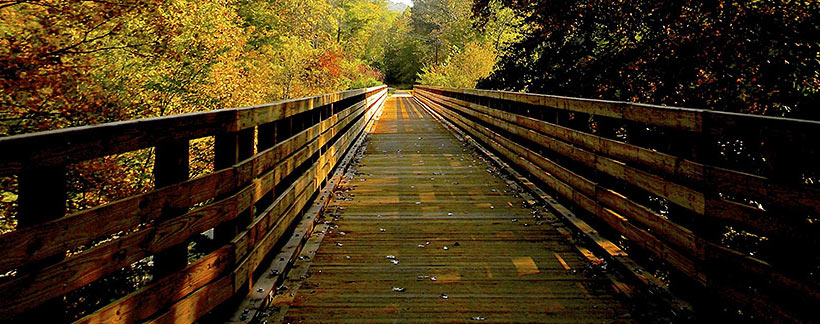Rail-trails were originally railroad corridors. Due to their railroad past, the terrain for rail-trails is generally flat or gently sloped and often connect communities and industries such as coal, coke, and limestone / sand. They are typically wide enough to accommodate multiple types of use – primarily bicycling, walking, running, riding a horse, and cross-country skiing. This makes rail-trails ideal places for all ages and abilities to recreate, exercise, and commute using alternative active transportation.
Railroad heritage is often seen through remnants along the rail-trails such as whistle posts, communication boxes, telegraph lines, train depots, coke ovens, and coal tipples. Logging railroads (aka timber lines, forest railways, or logging railways) are also rail-trails though they often used narrow gauge rail and were more temporary in nature. They are often steep and narrow trails that are now suited mostly for hiking and mountain biking. Some abandoned rail lines and bridges are developed and managed for ATV trails, especially in the Hatfield-McCoy Trail region of southern WV. WVRTC focuses our work on non-motorized rail-trails but appreciates the conservation and conversion of all abandoned rail lines as part of our heritage.
There are 562 miles of rail-trail, including 175 miles of logging rail-trail in West Virginia. They range in surfacing and width from 12 feet with asphalt surface or compacted limestone surface to very narrow 1 foot wide single track with dirt or loose rock surface. It is important to research each trail before planning your trip.
The WV Rails to Trails Council appreciates any feedback on your trail experience in order to keep our website current and to encourage best rail-trail design, build, and maintenance practices. Contact us at: info@wvrailtrails.org
There are 80 miles of abandoned rail corridors in West Virginia that have trail potential. These are often met with ownership challenges of having reverted back to private property. The challenge facing many of these corridors will be developing innovative ways of negotiating easements or recreational license agreements for public use.
Long-Distance Trails
Linking rail-trails together to form long distance trail networks increases the impact of benefits as a tourist destination and economic impact. There are several trail collaborations underway in West Virginia to create long distance trail networks.
The Industrial Heartland Trails Coalition is an effort to create a nearly continuous 1,400-mile multi-use trail system in 48 counties and the 4 states of Pennsylvania, New York, Ohio and West Virginia. The North Bend Rail-Trail, Harrison North Rail-Trail, West Fork River Trail, MC Trail, and Mon River Rail-Trail in WV and the planned Sheepskin Rail-Trail in PA will connect with the Great Allegheny Passage, and are a part of the P2P corridor that will be a 180-mile rail trail from Parkersburg, WV to Pittsburgh, PA. iHeartTrails.org
The New River Gorge Trail Alliance, an organization that promotes a regional trail system to connect gateway communities of the New River Gorge region with each other and the National and State Parks. NRGTA covers the 5 county region surrounding the New River Gorge (Fayette, Nicholas, Raleigh, Greenbrier and Summers Counties).
